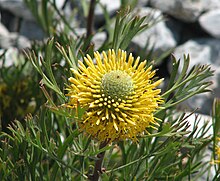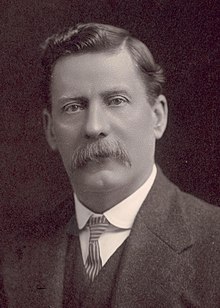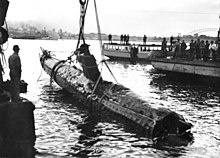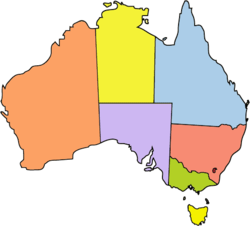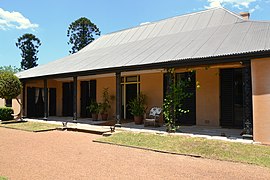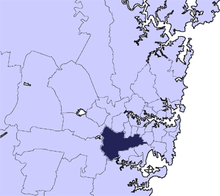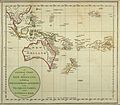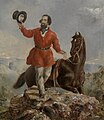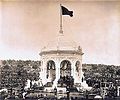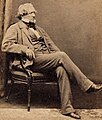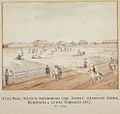Portal:New South Wales
Portal maintenance status: (June 2018)
|
The New South Wales Portal


New South Wales (commonly abbreviated as NSW) is a state on the east coast of Australia. It borders Queensland to the north, Victoria to the south, and South Australia to the west. Its coast borders the Coral and Tasman Seas to the east. The Australian Capital Territory and Jervis Bay Territory are enclaves within the state. New South Wales' state capital is Sydney, which is also Australia's most populous city. In December 2023[update], the population of New South Wales was over 8.3 million, making it Australia's most populous state. Almost two-thirds of the state's population, 5.3 million, live in the Greater Sydney area.
The Colony of New South Wales was founded as a British penal colony in 1788. It originally comprised more than half of the Australian mainland with its western boundary set at 129th meridian east in 1825. The colony then also included the island territories of Van Diemen's Land, Lord Howe Island, and Norfolk Island. During the 19th century, most of the colony's area was detached to form separate British colonies that eventually became the various states and territories of Australia. The Swan River Colony (later called the Colony of Western Australia) was never administered as part of New South Wales. (Full article...)
 Recognized content - load new batch
Recognized content - load new batch 
-
Image 1
Isopogon anemonifolius, commonly known as broad-leaved drumsticks, is a shrub of the family Proteaceae that is native only to eastern New South Wales in Australia. It occurs naturally in woodland, open forest, and heathland on sandstone soils. I. anemonifolius usually ranges between one and two metres in height, and is generally smaller in exposed heathland. Its leaves are divided and narrow, though broader than those of the related Isopogon anethifolius, and have a purplish tinge during the cooler months. The yellow flowers appear during late spring or early summer and are displayed prominently. They are followed by round grey cones, which give the plant its common name drumsticks. The small hairy seeds are found in the old flower parts.
A long-lived plant reaching an age of up to 60 years, I. anemonifolius resprouts from its woody base, known as a lignotuber, after bushfire. Seedlings appear in the year following a fire. Although I. anemonifolius was collected by Daniel Solander in 1770, it was not described until 1796 by Richard Salisbury. Several varieties have been named, though none are now recognised as distinct. It was first cultivated in the United Kingdom in 1791. I. anemonifolius grows readily in the garden if located in a sunny or part-shaded spot with sandy soil and good drainage. (Full article...) -
Image 2
Edward Davis Millen (7 November 1860 – 14 September 1923) was an Australian journalist and politician who served as the first Minister for Repatriation.
Millen emigrated to Australia from England around 1880 and established himself as a journalist, subsequently serving in the New South Wales Legislative Assembly from 1894 to 1898, during which time he fiercely opposed the proposed Federation despite supporting the principle. He was a member of the New South Wales Legislative Council from 1899 until his election to the Australian Senate as a Free Trader from New South Wales at the first federal election in 1901. Millen led the conservative parties in the Senate from 1907 until shortly before his death in 1923. (Full article...) -
Image 3A Japanese Ko-hyoteki class midget submarine, believed to be midget No. 14, is raised from Sydney Harbour the day after the attack.
From 31 May to 8 June 1942, during World War II, Imperial Japanese Navy submarines made a series of attacks on the Australian cities of Sydney and Newcastle. On the night of 31 May – 1 June, three Ko-hyoteki-class midget submarines, (M-14, M-21 and M-24) each with a two-member crew, entered Sydney Harbour, avoided the partially constructed Sydney Harbour anti-submarine boom net, and attempted to sink Allied warships. Two of the midget submarines were detected and attacked before they could engage any Allied vessels. The crew of M-14 scuttled their submarine, whilst M-21 was successfully attacked and sunk. The crew of M-21 killed themselves. These submarines were later recovered by the Allies. The third submarine attempted to torpedo the heavy cruiser USS Chicago, but instead sank the converted ferry HMAS Kuttabul, killing 21 sailors. This midget submarine's fate was unknown until 2006, when amateur scuba divers discovered the wreck off Sydney's northern beaches.
Immediately following the raid, the five Japanese fleet submarines that carried the midget submarines to Australia embarked on a campaign to disrupt merchant shipping in eastern Australian waters. Over the next month, the submarines attacked at least seven merchant vessels, sinking three ships and killing 50 sailors. During this period, between midnight and 02:30 on 8 June, two of the submarines bombarded the ports of Sydney and Newcastle. (Full article...) -
Image 4

James Thomas Walker (20 March 1841 – 18 January 1923) was an Australian banker and politician. He served as a Senator for New South Wales from 1901 to 1913.
Walker was born in Edinburgh, Scotland. He spent his early childhood in New South Wales, before returning to Scotland with his family to study finance. Joining the Bank of New South Wales, he returned to Australia and held various financial positions in New South Wales and Queensland. Gaining a public reputation for financial expertise, he was active in the Federationist cause and was a delegate to the 1897 Constitutional Convention, where he was a significant figure in the development of Commonwealth finance schemes. After assisting the successful "Yes" campaign for the 1898 referendum, he was elected to the Senate in 1901 as a Free Trader. (Full article...) -
Image 5

The Glasshouse arts and entertainment centre was central to the dismissal of Port Macquarie-Hastings Council
The dismissal of the Port Macquarie-Hastings Council on 27 February 2008 marked the end of a series of events involving a project which was initiated in 2001 in the New South Wales coastal town of Port Macquarie to build a cultural and entertainment centre, known to locals as the Glasshouse. The project, initially a joint venture with the management of the neighbouring shopping centre, Port Central, was originally expected to cost the Council A$7.3 million. However, by late 2007, despite the centre not yet having opened, the costs had blown out to over A$41.7 million, with interest repayments likely to extend the council's liability to A$66 million.
On 27 July 2007, a full public inquiry was announced by the Minister for Local Government, Paul Lynch. The inquiry reported its findings in February 2008. It found that the council had failed to provide appropriate financial and project management and had lost control of the costs, that the project costs had harmed the council's ability to provide services and amenities to the community, and that the council's communications management strategy had resulted in inadequate consultation with the public and inappropriate regard to their concerns. The Minister for Local Government dismissed the council and its mayor, Rob Drew, and appointed an administrator upon receiving the inquiry's report. Drew was critical of the process throughout, maintaining that errors had been made and misinformation had been accepted as fact; however, the New South Wales Urban Task Force, a property development lobby group, believed the sacking served as a warning to other councils to stick to "core responsibilities". (Full article...) -
Image 6
The Governor's Body Guard of Light Horse was a military unit maintained in the Colony of New South Wales between 1801 and 1834, and reputedly the "first full-time military unit raised in Australia". It was established by Governor Philip Gidley King by drawing men from the New South Wales Corps, the British garrison in the colony. Normally consisting of one or two non-commissioned officers and six privates, the Guard provided an escort to the governor and carried his despatches to outposts across the colony. From 1802, the men of the Guard were drawn from convicts pardoned by King. Men from the unit were deployed during the Castle Hill convict rebellion of 1804 and a trooper of the Guard assisted in the capture of two of the rebel leaders.
After King was succeeded by William Bligh in 1806, the Guard reverted to being drawn from the New South Wales Corps. The unit seems to have been absent during the Corps' 1808 mutiny against Bligh and, by one report, supported it. It was ordered to disband by the Earl of Liverpool but was granted a reprieve in 1812 by Liverpool's successor Earl Bathurst. Viscount Goderich ordered disbandment again in 1832 and Governor Richard Bourke transformed the unit into the Mounted Orderlies in 1834. These were absorbed into the New South Wales Mounted Police in 1836 and continued as a separate component within that force until at least 1860. (Full article...) -
Image 7
Isopogon anethifolius, commonly known as narrow-leaf drumsticks or narrow-leafed drumsticks, is a shrub in the family Proteaceae. The species is found only in coastal areas near Sydney in New South Wales, and to the immediate west. It occurs naturally in woodland, open forest and heathland on sandstone soils. An upright shrub, it can reach to 3 m (9.8 ft) in height, with terete leaves that are divided and narrow. The yellow flowers appear in the Spring, from September to December, and are prominently displayed. They are followed by round grey cones, which give the plant its common name of drumsticks. The small hairy seeds are found in the old flower parts.
Isopogon anethifolius regenerates after bushfire by resprouting from its woody base, known as a lignotuber, as well as from seed. It was described by Richard Salisbury in 1796, and was first grown in the United Kingdom the same year. One of the easiest members of the genus Isopogon to grow in cultivation, I. anethifolius grows readily in the garden if located in a sunny or part-shaded spot with sandy soil and good drainage. (Full article...) -
Image 8
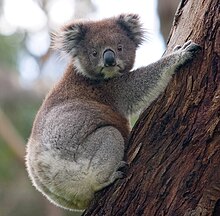
The koala (Phascolarctos cinereus), sometimes inaccurately called the koala bear, is an arboreal herbivorous marsupial native to Australia. It is the only extant representative of the family Phascolarctidae. Its closest living relatives are the wombats. The koala is found in coastal areas of the island's eastern and southern regions, inhabiting Queensland, New South Wales, Victoria, and South Australia. It is easily recognisable by its stout, tailless body and large head with round, fluffy ears and large, dark nose. The koala has a body length of 60–85 cm (24–33 in) and weighs 4–15 kg (8.8–33.1 lb). Its fur colour ranges from silver grey to chocolate brown. Koalas from the northern populations are typically smaller and lighter in colour than their counterparts further south. These populations are possibly separate subspecies, but not all researchers accept this.
Koalas typically inhabit open Eucalyptus woodland, as the leaves of these trees make up most of their diet. This eucalypt diet has low nutritional and caloric content and contains toxic compounds that deter most other mammals from feeding on them. Koalas are largely sedentary and sleep up to twenty hours a day. They are asocial; only mothers bond to dependent offspring. Adult males communicate with bellows that intimidate rivals and attract mates. Males mark their presence with secretions from scent glands located on their chests. Like other marsupials, koalas give birth to young known as joeys at a very early stage of development. They crawl into their mothers' pouches, where they live for their first six to seven months. They are fully weaned around a year old. Koalas have few natural predators and parasites, but are threatened by pathogens such as Chlamydiaceae bacteria and koala retrovirus. (Full article...) -
Image 9Banksia oblongifolia,
Georges River National Park
Banksia oblongifolia, commonly known as the fern-leaved, dwarf or rusty banksia, is a species in the plant genus Banksia. Found along the eastern coast of Australia from Wollongong, New South Wales in the south to Rockhampton, Queensland in the north, it generally grows in sandy soils in heath, open forest or swamp margins and wet areas. A many-stemmed shrub up to 3 m (9.8 ft) high, it has leathery serrated leaves and rusty-coloured new growth. The yellow flower spikes, known as inflorescences, most commonly appear in autumn and early winter. Up to 80 follicles, or seed pods, develop on the spikes after flowering. Banksia oblongifolia resprouts from its woody lignotuber after bushfires, and the seed pods open and release seed when burnt, the seed germinating and growing on burnt ground. Some plants grow between fires from seed shed spontaneously.
Spanish botanist Antonio José Cavanilles described B. oblongifolia in 1800, though it was known as Banksia aspleniifolia in New South Wales for many years. However, the latter name, originally coined by Richard Anthony Salisbury, proved invalid, and Banksia oblongifolia has been universally adopted as the correct scientific name since 1981. Two varieties were recognised in 1987, but these have not been generally accepted. A wide array of mammals, birds, and invertebrates visit the inflorescences. Though easily grown as a garden plant, it is not commonly seen in horticulture. (Full article...) -
Image 10
Grevillea juniperina, commonly known as juniper- or juniper-leaf grevillea or prickly spider-flower, is a plant of the family Proteaceae native to eastern New South Wales and southeastern Queensland in Australia. Scottish botanist Robert Brown described the species in 1810, and seven subspecies are recognised. One subspecies, G. j. juniperina, is restricted to Western Sydney and environs and is threatened by loss of habitat and housing development.
A small, prickly-leaved shrub between 0.2–3 m (0.66–9.84 ft) high, G. juniperina generally grows on clay-based or alluvial soils in eucalypt woodland. The flower heads, known as inflorescences, appear from winter to early summer and are red, orange or yellow. Birds visit and pollinate the flowers. Grevillea juniperina plants are killed by bushfire, regenerating afterwards from seed. Grevillea juniperina adapts readily to cultivation and has been important in horticulture as it is the parent of many popular garden hybrids. (Full article...) -
Image 11
St John the Baptist Anglican Church is an active Anglican church located between Alt and Bland Streets, Ashfield, a suburb of Sydney, New South Wales, Australia. Founded in 1840, on land donated by Elizabeth Underwood, the church building is the oldest authenticated surviving building in Ashfield, having been built at the time when subdivision increased the population density sufficiently to turn Ashfield into a town. It was also the first church built along the Parramatta Road which linked the early colonial towns of Sydney and Parramatta. The earliest remaining parts of the building are one of the first Sydney designs by the colonial architect Edmund Blacket, who later became renowned for his ecclesiastical architecture.
The expansive church grounds contain a cemetery dating back to 1845 that contains the remains of many notable Ashfield residents. Australia's only memorial to Australian Air Force Cadets occupies a prominent position near the entrance to the church. The St John's site has been listed on the Local Environment Plan Heritage Schedule, and the Register of the National Trust of Australia. (Full article...) -
Image 12

The Pacific blue-eye (Pseudomugil signifer) is a species of fish in the subfamily Pseudomugilinae native to eastern Australia. Described by Austrian naturalist Rudolf Kner in 1866, it comprises two subspecies that have been regarded as separate species in the past and may be once again with further study. It is a common fish of rivers and estuaries along the eastern seaboard from Cape York in North Queensland to southern New South Wales, the Burdekin Gap in central-north Queensland dividing the ranges of the two subspecies.
A small silvery fish averaging around 3.25 cm in total length (1+1⁄8–1+3⁄8 in), the Pacific blue-eye is recognisable by its blue eye-ring and two dorsal fins. It forms loose schools of tens to thousands of individuals. It eats water-borne insects as well as flying insects that land on the water's surface, foraging for them by sight. The Pacific blue-eye adapts readily to captivity. (Full article...) -
Image 13The murder of Leigh Leigh, born Leigh Rennea Mears, occurred on 3 November 1989 while she was attending a 16-year-old boy's birthday party at Stockton Beach, New South Wales, on the east coast of Australia. The 14-year-old girl from Fern Bay was assaulted by a group of boys after she returned distressed from a sexual encounter on the beach that a reviewing judge later called non-consensual. After being kicked and spat on by the group, Leigh left the party. Her naked body was found in the sand dunes nearby the following morning, with severe genital damage and a crushed skull.
Matthew Grant Webster, an 18-year-old who acted as a bouncer at the event, pleaded guilty to her murder and was sentenced to 20 years in prison with a 14-year non-parole period. He was released on parole in June 2004, after serving 14½ years. Guy Charles Wilson, the other bouncer and only other person aged over 18 at the party, pleaded guilty to assault; a third male (aged 15) pleaded guilty to having sex with a minor. The investigation of Leigh's murder proved controversial, however, as several people who admitted to various crimes, including assaulting Leigh, were never charged; nor was anyone ever charged with her sexual assault. Webster's confession did not match the forensic evidence. The murder investigation was reviewed by the New South Wales Crime Commission in 1996, and by the Police Integrity Commission in 1998, with the latter recommending the dismissal of the detective in charge of the investigation. (Full article...) -
Image 14A boat at Rose Bay in water which is being churned by the hailstones.
The 1947 Sydney hailstorm was a natural disaster which struck Sydney, Australia, on 1 January 1947. The storm cell developed on the morning of New Year's Day, a public holiday in Australia, over the Blue Mountains, hitting the city and dissipating east of Bondi in the mid-afternoon. At the time, it was the most severe storm to strike the city since recorded observations began in 1792.
The high humidity, temperatures and weather patterns of Sydney increased the strength of the storm. The cost of damages from the storm were, at the time, approximately £750,000 (US$3 million); this is the equivalent of around A$45 million in modern figures. The supercell dropped hailstones larger than 8 centimetres (3.1 in) in diameter, with the most significant damage occurring in the central business district and eastern suburbs of Sydney. (Full article...) -
Image 15Abbotsford Bridge from the Victorian riverbank
Abbotsford Bridge is a steel Allan truss-type road bridge that carries the Silver City Highway across the Murray River, between Curlwaa in New South Wales, and Yelta in Victoria, Australia. It is the only remaining steel truss bridge with a lift span that crosses the Murray. Opened in 1928, the bridge was built by the NSW Department of Public Works and was designed by Percy Allan. It was the second last vertical-lift bridge to be built over the river, the last being the Nyah Bridge, which opened in 1941.
The bridge was constructed over a three-year period from 1925. The project was not originally planned to take as long, but there were delays due to problems with a contractor, and industrial action. The bridge was designed to carry the Mildura railway line over the Murray River and into New South Wales, to service significant cross-border traffic arising from the fruit-growing industry, but the line was never extended beyond the terminus at Yelta. The bridge currently carries a single lane of road controlled by traffic lights. (Full article...)
Selected image

| Credit: Mike Lehmann |
Bondi Beach is a popular beach and the name of the surrounding suburb in Sydney, Australia.
Related portals
WikiProjects
Selected articles - load new batch
-
Image 1Cabbage Tree Island may refer to three locations in New South Wales, Australia:
- Cabbage Tree Island, New South Wales, a settlement in Ballina Shire
- Cabbage Tree Island (John Gould Nature Reserve), an island and nature reserve near Port Stephens
- Cabbage Tree Island, near Old Bar in the Manning River Entrance State Park, NSW
-
Image 2The history of New South Wales refers to the history of the Australian state of New South Wales and the area's preceding Indigenous and British colonial societies. The Mungo Lake remains indicate occupation of parts of the New South Wales area by Indigenous Australians for at least 40,000 years. The British navigator James Cook became the first European to map the coast in 1770 and a First Fleet of British convicts followed to establish a penal colony at Sydney in 1788.
The colony established an autonomous parliamentary democracy from the 1850s and became a state of the Commonwealth of Australia in 1901 following a vote to federate with the other British colonies of Australia. Through the 20th century, the state was a major destination for an increasingly diverse collection of migrants from many nations. In the 21st century, the state is the most populous in Australia, and its capital, Sydney is a major financial capital and host to international cultural and economic events. (Full article...) -
Image 3
The Central Coast is a peri-urban region lying on the Pacific Ocean in northern-eastern New South Wales, Australia. The region is situated north of Sydney, which is filled with subtropical national parks, forests and also encompasses the major coastal waterways of Brisbane Water, Tuggerah Lakes and southern Lake Macquarie. The region's hinterland, which has fertile valleys, rural farmland and wineries, and also includes the Watagan Mountains. The Central Coast is known for its regional coastal towns like Terrigal, The Entrance, Ettalong Beach, Budgewoi and Bateau Bay with resorts and holiday parks, which feature many expansive beaches and lagoons with surfing and coastal tracks, as well as scenic views. Gosford is the main commercial hub and gateway.
The Central Coast includes major localities, villages and towns such as Gosford, Wyong, Terrigal, Woy Woy and The Entrance. The area is the third-largest urban area in New South Wales and the ninth-largest urban area in Australia. Geographically, the Central Coast is generally considered to include the region bounded by the Hawkesbury River in the south, the Watagan Mountains in the west and Lake Macquarie, lying on the Sydney basin. (Full article...) -
Image 4
The Bank of New South Wales (BNSW), also known as The Wales, was the first bank in Australia. It was established in 1817 in Sydney. During the 19th century, the bank opened branches throughout Australia and New Zealand, expanding into Oceania in the 20th century. Throughout it history it merged with and purchased many other financial institutions. In 1981 it merged with the Commercial Bank of Australia and was renamed Westpac on 4 May 1982. (Full article...) -
Image 5The Sydney Bears (formerly Macquarie Bears) is an Australian semi-professional ice hockey team from Sydney, New South Wales. Established in 1982, the Bears are the only remaining founding member of the Australian Ice Hockey League (AIHL) still operating. The Bears are based at Macquarie Ice Rink, within the Macquarie Centre, in the northern suburbs of Sydney. The Sydney Bears are three time Goodall Cup champions and four time H Newman Reid Trophy premiers. (Full article...)
-
Image 6Sport in New South Wales describes participation in and attendance at organised sports events in the state of New South Wales in Australia. Sport forms an integral part of the culture of the state.
New South Wales has attracted many international multi-sport events including the 2000 Summer Olympics, held in Sydney. There are many professional sporting teams in New South Wales. The biggest sport in the state by a wide margin is rugby league, in which the state has 10 professional clubs in the National Rugby League. Other popular spectator sports include rugby union, cricket, Australian rules football and soccer. In terms of participation, the most popular sports in the state are netball, tennis, soccer, rugby league and touch football. (Full article...) -
Image 7Elizabeth Farm, the first item inscribed on the Register
The New South Wales State Heritage Register, also known as NSW State Heritage Register, is a heritage list of places in the state of New South Wales, Australia, that are protected by New South Wales legislation, generally covered by the Heritage Act 1977 and its 2010 amendments. The register is administered by the Heritage Council of NSW via Heritage NSW, a division of the Government of New South Wales Department of Planning and Environment.
The register was created in 1999 and includes items protected by heritage schedules that relate to the State, and to regional and to local environmental plans. As a result, the register contains over 20,000 statutory-listed items in either public or private ownership of historical, cultural, and architectural value. Of those items listed, approximately 1,785 items are listed as significant items for the whole of New South Wales; with the remaining items of local or regional heritage value. The items include buildings, objects, monuments, Aboriginal places, gardens, bridges, landscapes, archaeological sites, shipwrecks, relics, bridges, streets, industrial structures and conservation precincts. (Full article...) -
Image 8View of Mount Duval with farms in the foreground
New England is a geographical region in the north of the state of New South Wales, Australia, about 60 km (37 mi) inland from the Tasman Sea. The area includes the Northern Tablelands (or New England Tablelands) and the North West Slopes regions. As of 2021, New England had a population of 185,560, with over a quarter of the people living in the area of Tamworth Regional Council. (Full article...) -
Image 9

Geoffrey Lee (born c. 1967) is a former Australian politician. He served as the Minister for Corrections in the second Perrottet ministry between December 2021 and March 2023. He has previously served as the Minister for Skills and Tertiary Education in the second Berejiklian and Perrottet ministries between April 2019 and December 2021. Lee was also a member of the New South Wales Legislative Assembly representing Parramatta for the Liberal Party since 2011 until his retirement in 2023. (Full article...) -
Image 101959 Sulman Medal
Australian Academy of Science
The Sir John Sulman Medal for Public Architecture is an architectural award presented by the New South Wales chapter of the Australian Institute of Architects since 1932. The medal is sometimes referred to as the Sulman Award and now recognises excellence in public buildings in either New South Wales or in the Australian Capital Territory. Before the advent of the Wilkinson Award in 1961, it was on occasion presented to residential housing projects.
The medal is presented in memory of the Australian architect Sir John Sulman (29 August 1849 – 18 August 1934). Sulman was born in Greenwich, England, and emigrated to Sydney in 1885. From 1921 to 1924 he was chairman of the Federal Capital Advisory Committee and influenced the development of Canberra. The medal was designed by George Rayner Hoff (1894—1937), sculptor and teacher, famed for his sculptures in Sydney's Anzac Memorial. (Full article...) -
Image 11
Campbelltown is a suburb located on the outskirts of the metropolitan area of Sydney, New South Wales, Australia. It is located in Greater Western Sydney 53 kilometres (33 mi) south-west of the Sydney central business district by road. Campbelltown is the administrative seat of the local government area of the City of Campbelltown. It is also acknowledged on the register of the Geographical Names Board of New South Wales as one of only four cities within the Sydney metropolitan area.
Campbelltown gets its name from Elizabeth Campbell, the wife of former Governor of New South Wales Lachlan Macquarie. Originally called Campbell-Town, the name was later simplified to the current Campbelltown. (Full article...) -
Image 12
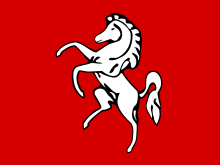
Invicta, the flag of the English county of Kent
Tooth and Co was the major brewer of beer in New South Wales, Australia. The company owned a large brewery on Broadway in Sydney from 1835 to 1985, known as the Kent Brewery. It was historically one of Australia's oldest companies, having been established as a partnership in 1835. The brand was revived in 2015. (Full article...) -
Image 13
Kristina Marie Kerscher Keneally (born 19 December 1968) is an American-born Australian politician who served as the first female Premier of New South Wales from 2009 to 2011 and was later a Labor Senator for New South Wales from February 2018 until April 2022. She resigned from the Senate to contest the House of Representatives seat of Fowler, but was unsuccessful. From 2019 to 2022 she served as Deputy Leader of the Opposition in the Senate, Shadow Minister for Home Affairs, and Shadow Minister for Immigration and Citizenship.
Keneally was born in the United States to an American father and an Australian mother. She grew up in Toledo, Ohio, and is a graduate of the University of Dayton. After marrying an Australian, Ben Keneally, she settled in Australia permanently and became a naturalised citizen in 2000. Keneally was elected to the New South Wales Legislative Assembly seat of Heffron at the 2003 state election, succeeding Deirdre Grusovin after a controversial preselection process. After being re-elected to parliament at the 2007 state election, she became the Minister for Ageing and Disability Services and was subsequently appointed Minister for Planning by Premier Nathan Rees in 2008. She was also the state government's spokeswoman for World Youth Day 2008. (Full article...) -
Image 14Location in Metropolitan Sydney
Canterbury-Bankstown Council, trading as the City of Canterbury Bankstown and stylised as CBCity, is a local government area in the Canterbury-Bankstown region of Sydney, New South Wales, Australia. The council was formed on 12 May 2016 from a merger of the City of Canterbury and the City of Bankstown, after a review of local government areas by the NSW Government.
The City of Canterbury Bankstown comprises an area of 110.8 square kilometres (42.8 sq mi) and as per the 2021 census, had a population of 371,006 making it the second most populous local government area in New South Wales. (Full article...) -
Image 15
Sydney Ferries is the public transport ferry network serving the city of Sydney, New South Wales. Services operate on Sydney Harbour and the connecting Parramatta River. The network is controlled by the New South Wales Government's transport authority, Transport for NSW, and is part of the authority's Opal ticketing system. In 2017–18, 15.3 million passenger journeys were made on the network.
Services are operated under contract by Transdev Sydney Ferries. Sydney Ferries Corporation is the state government agency that owns the ferry fleet. (Full article...)
Did you know (auto-generated)

- ... that in its two years of existence, the Hunter River Railway Company initiated construction on what would eventually become the Great Northern Railway connecting Sydney to Queensland?
- ... that many an Xplorer has traversed the rails in Canberra?
- ... that Turkish international soccer player Rojin Polat was named member of the "2021 All Schools Merit Girls Team" in New South Wales, Australia?
- ... that the rural village of Neath, New South Wales, had a population of three Tok Pisin speakers in 2021?
General images - load new batch
-
Image 1A General Chart of New Holland including New South Wales & Botany Bay with The Adjacent Countries and New Discovered Lands, published in An Historical Narrative of the Discovery of New Holland and New South Wales, London, Fielding and Stockdale, November 1786 (from History of New South Wales)
-
Image 3The 5th Governor of New South Wales, Lachlan Macquarie, was influential in establishing civil society in Australia (from History of New South Wales)
-
Image 4Humanitarian Caroline Chisholm provided support to poverty-stricken women migrants (from History of New South Wales)
-
Image 5Mr E.H. Hargraves, The Gold Discoverer of Australia, returning the salute of the gold miners - Thomas Tyrwhitt Balcombe, 1851 (from History of New South Wales)
-
Image 7Federation Pavilion, Centennial Park, Sydney, 1 January 1901. (from History of New South Wales)
-
Image 8Olympic colours on the Sydney Harbour Bridge in the year 2000 (from History of New South Wales)
-
Image 9Dry paddocks in the Riverina region during the 2007 drought (from History of New South Wales)
-
Image 10A chart of part of the interior of New South Wales by John Oxley, Surveyor General, 1822 (from History of New South Wales)
-
Image 13Japanese POW camp at Cowra, shortly before the Cowra breakout (from History of New South Wales)
-
Image 14William Wentworth was key in the establishment of self-governance in New South Wales (from History of New South Wales)
-
Image 15Founding of the settlement of Port Jackson at Botany Bay in New South Wales in 1788, by Thomas Gosse (from History of New South Wales)
-
Image 16Hyde Park, Sydney with the Australian Museum under construction in the distance, 1842 (from History of New South Wales)
-
Image 17World leaders with Prime Minister John Howard in Sydney for the 2007 APEC conference (from History of New South Wales)
-
Image 18Tumut 3 Power Station was constructed as part of the vast Snowy Mountains Scheme in New South Wales (1949–1974). Construction necessitated the expansion of Australia's immigration program. (from History of New South Wales)
-
Image 19The New South Wales Parliament is Australia's oldest parliament. (from History of New South Wales)
-
Image 21Ribbon ceremony to open the Sydney Harbour Bridge on 20 March 1932. Breaking protocol, the soon to be dismissed Premier Jack Lang cuts the ribbon while Governor Philip Game looks on. (from History of New South Wales)
-
Image 22Landing of Lieutenant James Cook at Botany Bay, 29 April 1770, by E. Phillips Fox (from History of New South Wales)
-
Image 23A bulk carrier entering the Port of Newcastle, New South Wales, 2009 (from Economy of New South Wales)
Topics
Categories
More portals
In the news
- 5 January 2025 – 2025 United Cup
- In tennis, the United States wins its second United Cup title after defeating Poland 2–0 in the final at the Ken Rosewall Arena in Sydney, Australia. (Reuters)
Associated Wikimedia
The following Wikimedia Foundation sister projects provide more on this subject:
-
Commons
Free media repository -
Wikibooks
Free textbooks and manuals -
Wikidata
Free knowledge base -
Wikinews
Free-content news -
Wikiquote
Collection of quotations -
Wikisource
Free-content library -
Wikiversity
Free learning tools -
Wikivoyage
Free travel guide -
Wiktionary
Dictionary and thesaurus


